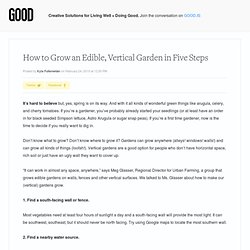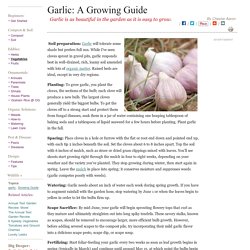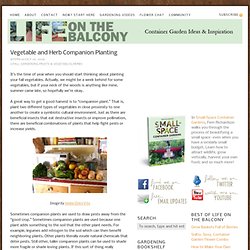

Organic Gardening Guide to Correct Seed Planting Depth. As a rule, seeds should not be buried any deeper than their diameter. Forget the quarter-inch planting depths you see on many seed packets. That's too deep for all but the biggest seeds, such as peas and beans. Some seeds even need light to germinate—don't bury those at all. Cover these seeds: Beets Broccoli Cabbage Cauliflower Celery Chard Cucumbers Melons Onions Parsley Peas Radishes Spinach Sow these seeds on top of the soil for best germination: Ageratum Astilbe Balloon flower Cleome Coleus Coreopsis Dill Impatiens Lettuce Mexican sunflower (aka tithonia) Ornamental peppers Petunias Savory Shasta daisy Snapdragon Strawflower Stock Sweet alyssum Yarrow.
Compost Soil - How to Add Compost to Soil Video. Adding compost to soil is an excellent way to give your garden much needed nutrients and extra moisture. Potting Soil Recipes. Seeds Of Change. Byron's World Famous Tea Recipe For Starting Seeds (Entire Thread) - Posted by: Byron 4a/5b NH (My Page) on Tue, Feb 26, 02 at 10:36 I use a weak tea formula.

Make a cup of tea, anything that you have. Let it steep for 4 min, then dump it. Make a second cup with the same bag. Homemade Organic Aphid Spray. Aphids are pesky little critters who usually top a gardener's list of "most hated" insect pests.

The tiny pearly green or milky white insects are almost impossible to avoid. They love just about all vegetables and ornamentals. Apple trees, roses and beans are especially susceptible to aphid attack, and symptoms of aphid infestation include curled leaves, deformed fruit and honeydew secretions on the plant. Fortunately, aphids can be controlled well with several cultural practices, and chemical controls are seldom necessary. Identifying AphidsOnce aphids are noticed, act quickly. Home - Trew Organic Produce, Berkshire Pork and Shropshire Sheep breeders. Organic Pest Control, Biological Solutions for Pest Management, Rincon Vitova Insectaries.
Georgia Interactive USDA Plant Hardiness Zone Map. The Antique Rose Emporium. Sources of Organic Fertilizers and Amendments Search Results: ATTRA - National Sustainable Agriculture Information Service. Amend soil with rock phosphate. April 28, 2002|By Dennis Bishop | Dennis Bishop,Special to the Sun Q.

We are planting asparagus in our community garden plot and it was recommended that we incorporate rock phosphate into the soil before planting. What is rock phosphate? A. Phosphate rock or rock phosphate is highly recommended by organic growers. It also contains a number of trace elements important to plants. Q. Vegetable Seed Viability. Do-It-Yourself Soil Test - How to Test Soil Acidity/Alkalinity without a Test Kit - StumbleUpon. Everything You Need to Know About Composting With Worms. Following my recent blog post on the Do-It-Yourself Vermipod, I’ve been receiving a ton of questions from folks who built Vermipods and are looking for information on how to manage and maintain their new pets.

So here’s a compilation called Everything You Need To Know About Composting With Worms… Common Worm Species Eisenia fetida: Pronounced “iSEEnee a FETid a”, is a worm that can process a large amount of organic material in their natural environment. They tolerate large temperature, moisture and pH ranges and can also tolerate handling well. Eisenia andrei is closely related to the Eisenia fetida and is known as the “red tiger”. Lumbricus rubellus is another worm that can be used for vermiposting. Bedding Materials. How to Grow an Edible, Vertical Garden in Five Steps - Cities. It’s hard to believe but, yes, spring is on its way.

And with it all kinds of wonderful green things like arugula, celery, and cherry tomatoes. How to Grow 100 Pounds of Potatoes in 4 Square Feet. On many occasions, we've been tempted to grow our own potatoes.

They're fairly low maintenance, can be grown in a pot or in the ground, last a fairly long time if stored properly, and can be very nutritious (high in potassium and vitamin C). Here's more incentive: according to this article, you can grow 100 pounds of potatoes in 4 sq. feet. Learn how after the jump... According to this article from the Seattle Times, potatoes planted inside a box with this method can grow up to 100 pounds of potatoes in just 4 square feet. How to Grow Garlic. Soil preparation: Garlic will tolerate some shade but prefers full sun.

While I've seen cloves sprout in gravel pits, garlic responds best in well-drained, rich, loamy soil amended with lots of organic matter. Raised beds are ideal, except in very dry regions. Planting: To grow garlic, you plant the cloves, the sections of the bulb; each clove will produce a new bulb. ORGANIC GARDENING. Organic gardening. Organic Gardening. Organic gardening. Organic garden. Organic Garden. Plant Science. Eco Gardening. Garden. Gardening. 5 Products that Will Get Your Kids Excited About Gardening This Year. Companion Plants. Garden designs & gardening tips. Natural, Organic and Conventional.
Landscape Material Lawrenceville GA. Gardening & Foraging. Gardening Resources, Cornell University. Most people think of plants as very passive organisms.

They grow almost unperceptively, and only once a year do they flower or produce edible products. However, plants are very active in ways that are not so obvious to the casual observer. For example, plants change the chemistry of the soil, and influence the types of microorganisms that grow there. They actively compete with other plants for space. Seeds and Plant Sources. Nimble NiteCap Seed Co. Vegetable Garden Planner — Design Your Best Garden Ever. Vegetable and Herb Companion Planting. It’s the time of year when you should start thinking about planting your fall vegetables.

Actually, we might be a week behind for some vegetables, but if your neck of the woods is anything like mine, summer came late, so hopefully we’re okay. A great way to get a good harvest is to “companion plant.” That is, plant two different types of vegetables in close proximity to one another to create a symbiotic cultural environment. Just as there are beneficial insects that eat destructive insects or improve pollination, there are beneficial combinations of plants that help fight pests or increase yields. Companion Planting. Garden Hints. Gardening Techniques. Problem Solver.